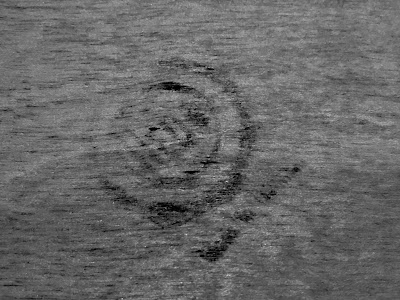I little while back, I bought a lovely old wooden caravan as a home for my Grecon clown Corny.
I had no idea of the maker but thought it was just the thing for a travelling clown.
I did find a maker's mark on the underside of the veranda (which slots underneath the middle of the caravan when it's on the road) but I couldn't quite make it out.
I thought it might say 'HEDO Made in Germany' but searching on the web with that didn't get me anywhere.
And then, just this afternoon, I took delivery of an excellent book that I've been after for years: Marianne Cieslik's and Swantje Köhler's ' Lexikon der Puppenstuben und Puppenhäuser' [sadly out of print now and as hard to come by, at least at a reasonable price, as hens' teeth] and while browsing through it I saw a photo that stopped me in my tracks.
Here was a German toy company by the name of HEDO.
I immediately did a web search for the name Herbert Dohnalek Spielzeug [toy] and that lead quickly to the brilliant font of knowledge that is diepuppenstubensammlerin's blogspot where she has shared a chronology of Herbert Dohnalek.

And there, right at the start of the chronology, was a photo of an almost identical caravan in a 1951 catalogue photo.
I don't think the caravan in the photo has the pull-out-and-slot-on veranda that mine has as I can't see the little wooden bits that pull out to hold the canopy, and the bit under the caravan where the slide-out veranda is stored on mine is hinged in the photo (mine isn't) and looks to be more of a storage box.
I can see from the photograph that the odd little assortment of furniture (above) that came with my caravan is all original.
What looks like a little plant pot in this photo, can't be seen in the 1951 catalogue photo, but I have now discovered that it could be the shade from little lamp table which was also part of the original furnishings - see below under 'UPDATE'.
There are three of the little dining chairs missing and the night-time bed (the bed I have appears to be a day bed) but otherwise, it seems to be a full set, even down to the radio, though my radio looks to be more basic than the one in the photo.
[Since I've now furnished the caravan to suit Corny the clown, I'll have to carefully store this furniture with a note explaining that it's original to the caravan and hope that it stays together in the future - maybe I'll add a sticker to the underside of the caravan too indicating that there is box of original furniture to go with it.]
I can also see from the photos of dolls' houses in diepuppenstubensammlerin's blog that the tiny and extremely neat blanket stitch in a contrasting colour around the edge of the curtains is a feature of the curtains in Herbert Dohnalek houses and so I suppose that they're original too.
I get unashamedly excited when I identify things I've been trying fruitlessly to research so this little gift has made my day!
UPDATE
I am only just getting around to posting this update now, having actually discovered the information almost two years ago!
In July, 2018 an eBay listing in Germany for an "Old Circus Wagon from 1952" was brought to my attention.
The photos accompanying the listing showed a caravan just like my Hedo/Herbert Dohnalek one - how exciting to see another with its original tractor and in full colour too! And, luckily, the eBay seller was kind enough to give me permission to show her photos in this blog.
 |
| Photo copyright: Bettina. |
The listing details (translated from German) were as follows:
“You are bidding on a beautiful, very well-maintained circus wagon with tractor from the year 1952. The wagon can be opened at the side and used as a kind of dollhouse……The wagon is furnished with bed, wardrobe (to open), a couch, floor lamp, table and two chairs. At the end of the wagon, a wooden frame can be pulled out and covered with a kind of awning. Steps lead into the back of the wagon where the double-leaf door is easy to open. The six windows of the circus wagon have curtains and there is a drawer under the wagon which can be pulled out easily and used for storage. A tractor that can be easily uncoupled pulls the car. The whole team has a length of about 62 cm, the circus wagaon is 34 cm long, 25 cm high and 18 cm wide. The tractor is 22 cm long and 13 cm high.”
 |
| Copyright: Bettina |
 |
| Copyright Bettina |
 |
| Copyright: Bettina |
The original furniture is shown in these photos too and one further discovery was that what I thought was a little plant pot which came with mine, is the same as the lamp shade on the lamp-table in the photo above. Sadly, mine is missing the table and lamp apart from the shade but it's good to know it's part of the original furnishings.
I now also have confirmation that the curtains in my caravan are original as they are exactly the same fabric as those seen in these photos.
 |
| Copyright: Bettina |
Until next time,
Zoe











